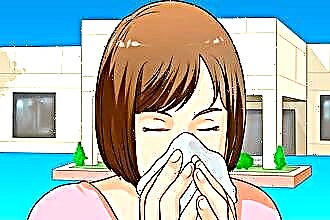One of the common symptoms of a cold is a runny nose. It can manifest itself as abundant rhinorrhea or scanty purulent discharge, which indicates their accumulation in the paranasal cavities. In any case, a full treatment of the disease with the use of modern medicines is required. Antibiotics in the nose are prescribed for the microbial form of rhinitis, as well as for a complicated course of the common cold, when a secondary infection occurs.
 In most cases, antibacterial drugs for intranasal administration are used for sinusitis (sinusitis, frontal sinusitis, ethmoiditis). Sometimes long-term allergic rhinitis can be complicated by the addition of a bacterial infection, which is also an indication for antibiotic therapy.
In most cases, antibacterial drugs for intranasal administration are used for sinusitis (sinusitis, frontal sinusitis, ethmoiditis). Sometimes long-term allergic rhinitis can be complicated by the addition of a bacterial infection, which is also an indication for antibiotic therapy.
With the generalization of the infectious process, systemic antibiotics can be used in order to reduce intoxication, fight microbes and eliminate the general manifestations of the disease. Often they are prescribed for high hyperthermia, immunodeficiency, high risk of bacterial damage to internal organs (pyelonephritis, myocarditis).
A topical antibiotic is used for:
- the presence of thick nasal discharge with a green tint;
- fetid coryza;
- soreness in the area of the paranasal cavities;
- headache;
- severe nasal congestion, which makes it difficult for the outflow of purulent mucus from the sinuses;
- hyperthermia.
Preventive local antibiotic therapy is prescribed to prevent the spread of infection to surrounding healthy tissues and chronic inflammation.
Medicines can be used in the form of a solution for drip dosing, as well as a spray or ointment.
The most commonly prescribed antibacterial drugs include:
- Isofra;
- Polydex;
- Bioparox.
In addition to the listed drugs, some sources indicate the possibility of using drops Garazon, Sofradex, which are intended for instillation of ears and eyes.
Isofra
The main active ingredient is framycetin, due to which the antibacterial effect of the drug is provided. Isofra is in the form of a spray intended for intranasal administration.
The medication is prescribed:
- with rhinitis;
- with nasopharyngitis;
- with sinusitis;
- in the postoperative period for the prevention of infectious complications.
Contraindications
Contraindications include age up to a year, as well as individual intolerance to antibiotics of the aminoglycoside group. Before using Isofra during pregnancy, you should consult your doctor, as the drug can have a toxic effect on the fetus.
The drug can penetrate into breast milk, which limits its use during the lactation period.
Doses and adverse reactions
Adults are prescribed one spray four times a day. According to indications, the frequency of administration can be increased to six. From one year of age, the solution is applied one spray three times.
The duration of the therapeutic course is 10 days.
In rare cases, after using the spray, an allergic reaction with skin symptoms may occur.
Polydexa
 The drug consists of two antibacterial substances (neomycin, polymyxin B), a hormonal (dexamethasone) and a vasoconstrictor (phenylephrine) component. Thanks to its powerful composition, Polydex has:
The drug consists of two antibacterial substances (neomycin, polymyxin B), a hormonal (dexamethasone) and a vasoconstrictor (phenylephrine) component. Thanks to its powerful composition, Polydex has:
- anti-inflammatory action;
- decongestant;
- antiallergic;
- antibacterial.
In addition, the medicine facilitates nasal breathing and normalizes the outflow of purulent mucus from the paranasal cavities. The medicinal solution is available in the form of a spray.
Indications and contraindications
The remedy is prescribed for infectious and inflammatory diseases of the nasal passages, paranasal cavities.
Contraindications include:
- pregnancy;
- age up to 15 years;
- lactation period;
- individual intolerance to the constituents of the drug;
- complications of severe hypertension (impaired cerebral blood flow, myocardial infarction);
- heart failure;
- glaucoma;
- retention of urine;
- convulsions, epilepsy;
- the acute phase of a viral disease;
- a course of antidepressants;
- taking vasoconstrictor drugs of systemic action, which, in combination with Polydex, can provoke a hypertensive crisis.
Caution must be observed when used simultaneously with aspirin, the dose of which exceeds 3 g per day.
Doses and adverse reactions
The antibiotic in the nose is applied daily, one spray up to five times. From the age of 15, it is recommended to administer one dose three times a day. The course is 5 days.
To accurately dose the medicinal solution, the first two sprays from the bottle should be done into the air.
After spraying into the nasal passages, Polydex may cause:
- local allergic reaction in the form of hyperemia of the mucous membrane, tissue edema;
- cardiopalmus;
- glaucoma crisis;
- dryness in the nasopharynx;
- nausea, vomiting;
- headache;
- convulsions;
- irritability;
- insomnia;
- excitation;
- hallucinations;
- chills, fever;
- dysuric disorders (in the presence of diseases of the urinary tract);
- retention of urine;
- increased sweating;
- skin rash;
- hives, itching sensations;
- arterial hypertension.
Bioparox
 The main active ingredient of the drug is fusafungin. It has antibacterial, anti-inflammatory properties.
The main active ingredient of the drug is fusafungin. It has antibacterial, anti-inflammatory properties.
The vial contains 400 doses. The drug is available in the form of an aerosol for intranasal or pharyngeal administration (that is, in the nasal passages, throat).
Fusafungin is not absorbed into the systemic bloodstream, therefore, in consultation with the doctor, it is allowed to use it during pregnancy if antibiotic therapy is necessary.
Indications and dosages
Bioparox is used for infectious and inflammatory diseases of the nasopharynx, upper respiratory tract, namely:
- rhinitis;
- nasopharyngitis;
- sinusitis;
- laryngitis;
- tonsillitis.
Also, the drug is prescribed after surgery on the nasopharynx to prevent infectious complications.
Adults are recommended to take 4 inhalations every 4 hours. The duration of the therapeutic course should not exceed 10 days. A child from 2.5 years old is prescribed two inhalations every 6 hours.
Adverse reactions and contraindications
Usually Bioparox is well tolerated. In rare cases, undesirable consequences may appear in the form of dryness in the nasal passages, sneezing. These reactions are not a manifestation of allergies, therefore, the use of the drug can be continued.
In the presence of a tendency to allergic reactions, the appearance of swelling of the mucous membrane, face, hyperemia of the tissues of the nose, bronchospasm, skin rashes, itching sensations, as well as increased nasal congestion and an increase in the volume of mucous secretions. In this case, the use of Bioparox should be canceled.
Contraindications include individual intolerance to the components of the drug, as well as age up to 2.5 years.
How to do inhalation correctly?
To get the maximum effect from the drug, you need to follow the recommendations for using Bioparox. So, it is necessary:
- take out the bottle, nozzle from the packaging;
- remove the protective cap;
- put a nozzle on the top of the bottle;
- keep the bottle upright;
- insert the nozzle into the nasal passage;
- push the spray
Remember to clean the nasal passages of mucus and dry crusts with saline before spraying the antibacterial agent.
Antiseptics
In addition to drugs, which include an antibiotic, drugs with antiseptic properties can be used for therapy. They act much softer, have fewer contraindications, side reactions.
The main indication for their appointment is infectious inflammation in the nasal passages, paranasal sinuses. They are distinguished by a wide antiseptic spectrum, reduce the severity of inflammation, sanitize the infectious focus, thereby eliminating the cause of the disease.
Among antimicrobial drugs, it is worth highlighting:
- Sialor (Protargol);
- Miramistin;
- Furacilin.
| Sialor (Protargol) | Miramistin | Furacilin | |
|---|---|---|---|
| Action | Antiseptic, astringent, protective | Broad spectrum antimicrobial, some immunostimulating, protective | Antimicrobial, protective, anti-inflammatory, cleansing |
| Release form | Intranasal drops | Intranasal spray, drip dosing solution | Solution, tablet form |
| Cooking method | A tablet (200 mg) should be dissolved in a vial with a solvent (10 ml). We get a 2% solution | Produced ready-made. The bottle has a spray dispenser | The tablet should be thoroughly crushed, dissolved in 100 ml of water. |
| Indications | Prevention of viral diseases during an epidemic, treatment of infectious pathologies | For the prevention, treatment of ENT, urogynecological organs | With a therapeutic purpose for infectious diseases of the nasopharynx, paranasal cavities |
| Contraindications | Hypersensitivity, pregnancy, lactation period | Hypersensitivity, age up to one year | Hypersensitivity, frequent nasal bleeding, hyperthermia |
| Mode of application | Dripping 1-2 drops three times. The course is 5-7 days. Before instillation, the mucous membrane should be cleaned with saline. | Dripping two drops three times. Rinse the nasal passages three times a day. For prophylactic purposes - one dose once a day. A child under 12 years old requires dilution with saline 1: 3 | Rinse the nasal passages up to four times a day, after which you need to blow your nose well |
| Adverse Reactions | Rarely, after instillation of the nasal passages, dryness, burning, itching sensations appear | In rare cases, there is a slight burning sensation in the nasal passages lasting 10 seconds. Dryness in the nasopharynx is also possible. | Adverse reactions occur only when the solution is swallowed. Among them, it is worth highlighting nausea, dizziness, allergies. |
| Note | Appointed to infants. It is not recommended to use simultaneously with vasoconstrictor agents. | It is prescribed for pregnant women, during the lactation period | It is not prescribed for viral diseases, since it is ineffective. Indicated for external use in pregnant women |
| Storage period | Within a month after preparation | According to the date on the package | Within 10 days of preparation |
Antiseptics to a lesser extent affect the microflora of the nasopharynx, therefore, they have a minimal risk of disruption of its composition and the development of mycoses.
Antibiotics for the nose are one of the components of therapy for diseases of the nasopharynx and paranasal sinuses. Their purpose is indicated for chronic inflammation, as well as an infectious process for the rehabilitation of a pathological focus. Despite the high effectiveness of antibacterial agents, one should not forget about anti-inflammatory, antihistamines and vasoconstrictor drugs, which are necessary for a quick recovery.



